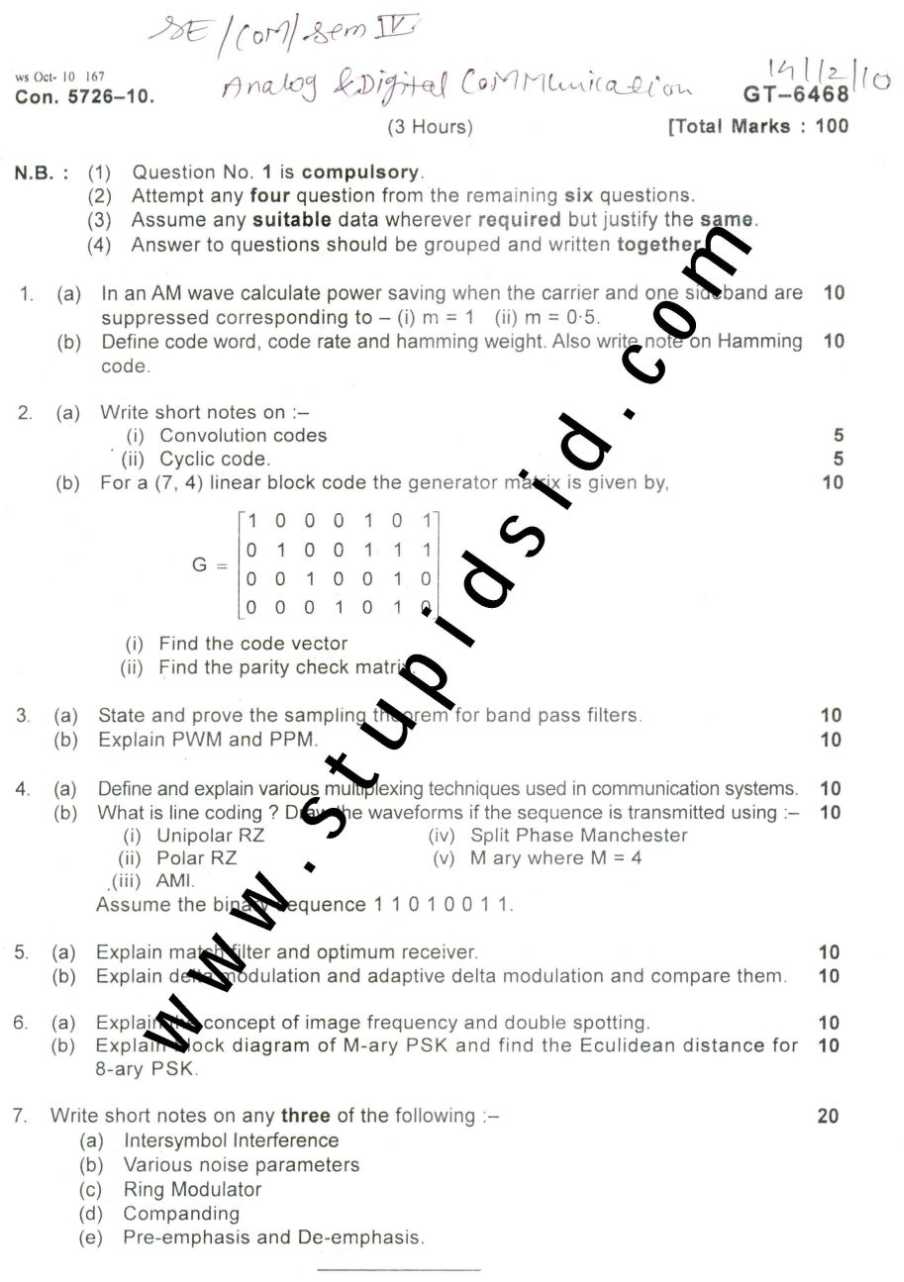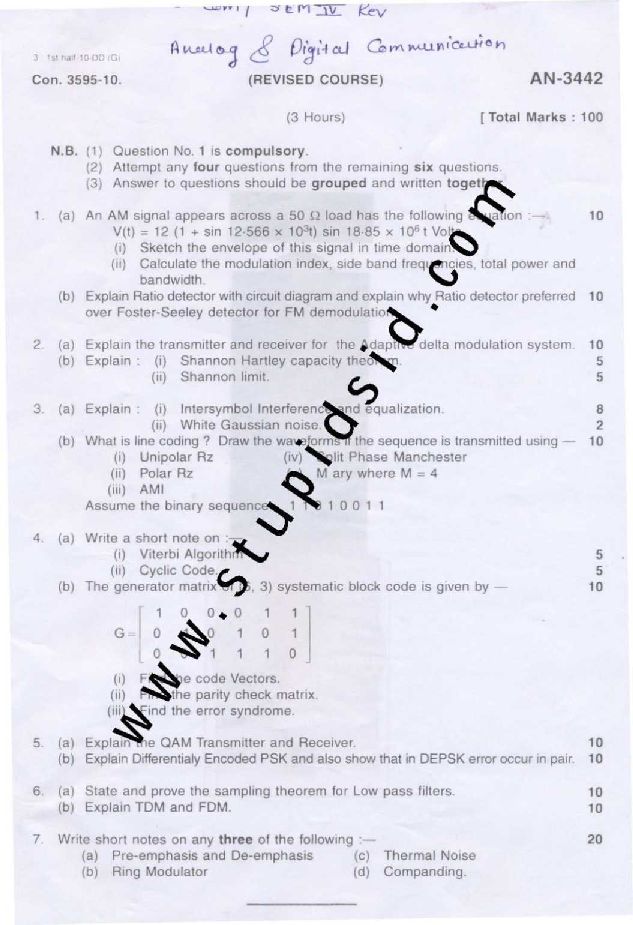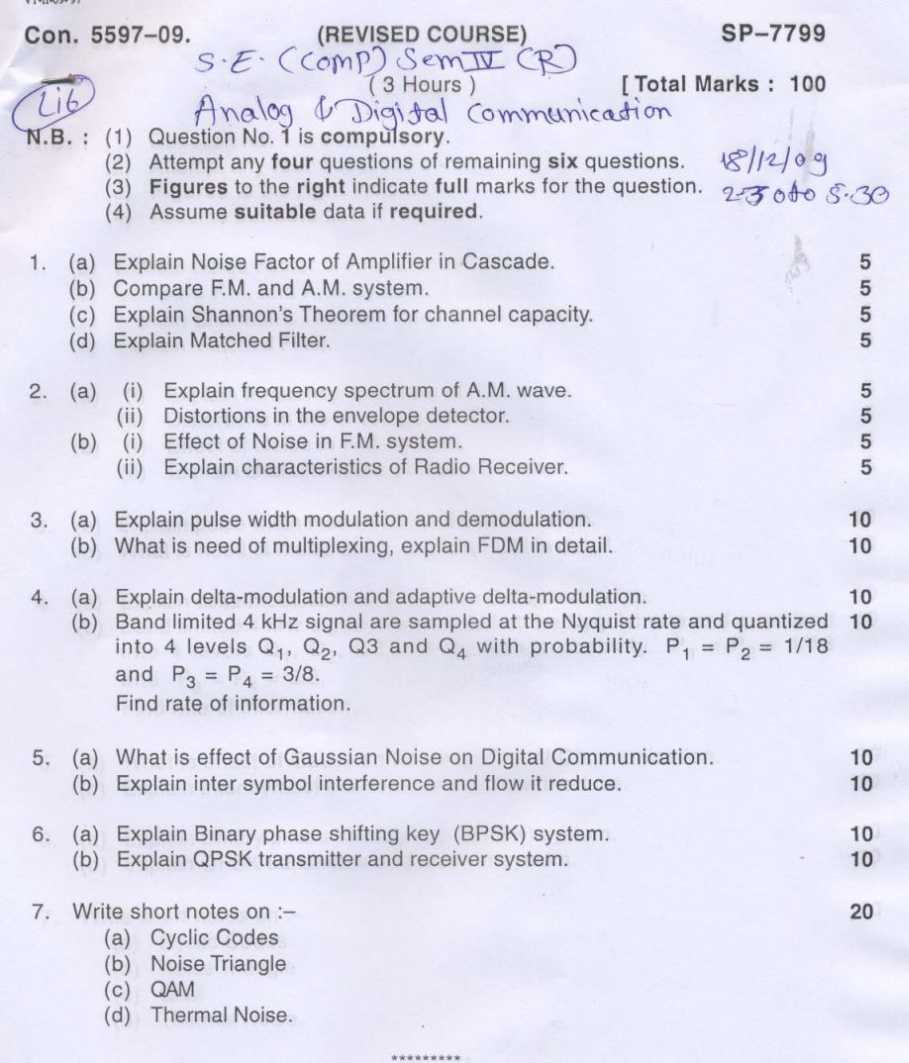|
#1
| |||
| |||
|
Will you please give me the Mumbai University, B.E in Computer Science, 4th Sem., Analog and Digital Communication previous years question papers? The University of Mumbai is one of the first three state universities in India and the oldest in Maharashtra. It is located in Mumbai, Maharashtra. The University is approved by UGC. MU B.E Computer Engineering 4th semester Syllabus Course Code Course Name CSC401 Applied Mathematics IV* CSC402 Analysis of Algorithms CSC403 Computer Organization and Architecture* CSC404 Data Base Management systems CSC405 Theoretical Computer Science CSC406 Computer Graphics Course Code Course Name CSC401 Applied Mathematics IV* CSC402 Analysis of Algorithms CSC403 Computer Organization and Architecture* CSC404 Data Base Management systems CSC405 Theoretical Computer Science CSC406 Computer Graphics Course Code Course Name CSC301 Applied Mathaematics III MU B.E Computer Engineering 4th semester Syllabus Subject Code Subject Name Credits Course Objectives: 1. To develop the knowledge of semiconductor devices and circuits, and explain their use in communication applications. 2. To inculcate circuit analysis capabilities in students. 3. To make students aware of various types of integrated circuits that can be used in computer applications. 4. To make students aware that knowledge gained in electronic devices and circuits is useful in real life applications. Course Outcomes: 1. Ability to understand and use semiconductor devices in circuits. 2. Ability to analyze the given circuit. 3. Ability to understand field effect devices and carry out their DC analysis. 4. Ability to understand concept of feedback and oscillations. 5. Ability to use oscillators in various applications. 6. Ability to use operational amplifier in various applications. 7. Ability to understand concept of phase lock loop and their use communication applications. 8. Ability to understand fundamental concepts of communication. 9. Ability to apply knowledge of electronic devices and circuits to communication applications. Module Detailed content Hours Electronic Circuits • Field effect based devices and circuits: • Junction Field Effect Transistors, JFET Characteristics, • FET amplification and switching, • DC load line and bias point, ate bias, self bias, voltage divider bias, coupling, bypassing and AC load lines, • FET models and parameters, • Common source circuit analysis principle of oscillation, • FET based Hartley and Colpitts Oscillator. • Crystal oscillator • BJT as power amplifier ( only class A and C) • Operational Amplifier and its applications: • Op-amp parameters and characteristics, • Inverting and Non-inverting amplifier, • Comparator, • Summing Amplifier, • Integrator, • Differentiator, • Zero Crossing Detector. • Phase Lock Loop: • Operating principle of PLL, • Lock range and capture range. Modulation • Principles of Analog Communication: • Elements of analog communication systems, • Theory of amplitude modulation and types of AM, • Generation of DSB SC using balanced modulator, • Generation of SSB using phase shift method • Theory of FM and PM, • Generation of FM by Armstrong method Demodulation : • Principle of super heterodyne receiver. • Foster seely detector for FM detection • Application of PLL (IC 565) as FM detector , Frequency translator, Phase shifter, and freq synthesizer 06 05 • Concept of sampling :Sampling Theorem, Types of sampling Quantization , A/D and D/A conversion concept • Pulse Modulation: generation and detection of PAM, PPM, PWM, PCM, DM and ADM.Principle of TDM and FDM. Text Books: 1. David Bell, ‘Electronic Devices and Circuits’, Oxford, 5th Edition. 2. Wayne Tomasi ‘Electronic Communication Systems (fundamentals through advanced)’, Pearson Education, 4th Edition. 3. Ramakant A. Gayakwad, ‘Op-amp and linear integrated circuits’, PHI, 3rd edition. 4. G. Kennedy, B. Davis, S R M Prasanna, ‘Electronic Communication Systems’, Mc Graw Hill, 5th Edition. References: 1. Robert Diffenderfer, ‘Electronic Devices: Systems & Applications’, Cengage Learning, India Edition. 2. K. R. Botkar, ‘Integrated Circuits’, Khanna Publishers, 9th Edition 3. Donald Neamen, ‘Electronic Circuit Analysis and Design’, Tata McGraw Hill,2nd Edition. 4. David Bell, ‘Electronic Devices and Circuits’, Oxford, 5th Edition. 5. Wayne Tomasi ‘Electronic Communication Systems (fundamentals through advanced)’, Pearson Education, 4th Edition. 6. Ramakant A. Gayakwad, ‘Op-amp and linear integrated circuits’, PHI, 3rd edition. 7. G. Kennedy, B. Davis, S R M Prasanna, ‘Electronic Communication Systems’, Mc Graw Hill, 5th Edition. 8. Robert Diffenderfer, ‘Electronic Devices: Systems & Applications’, Cengage Learning, India Edition. 9. K. R. Botkar, ‘Integrated Circuits’, Khanna Publishers, 9th Edition 10. Donald Neamen, ‘Electronic Circuit Analysis and Design’, Tata McGraw Hill,2nd Edition. Termwork: Term work should consist of at least 08 experiments. Journal must include at least 2 assignments. The final certification and acceptance of term work ensures that satisfactory performance of laboratory work and minimum passing marks in term work. Term Work: 25 Marks ( total marks ) = 15 Marks ( Experiment ) + 5 Marks ( Assignment ) + 5 (Attendance (theory+practical)) Oral exam will be based on the above syllabus. Suggested List of Experiments: 1. Study of various test and measuring instruments 2. Implementation of diode detector 3. Implementation of single stage FET amplifier 4. Implementation of oscillators 5. Implementation of IC 741 based application 6. Implementation of IC741 based active filters 7. Implementation of IC555 based application 8. Troubleshooting of given faults 9. Modulation and demodulation of AM/SSB/FM 10. Study of superheterodyne receiver 11. Generation and detection of PAM/PPM/PWM 12. Generation and detection of PCM/DM/ADM 13. Study of FDM and TDM 14. SPICE based simulations Important Note: • 50% experiments from communication and 50% experiments from electronic circuits should be taken. • In theory exam the weightage for marks out of 80 : 35 for Devices and 45 for communications Theory Examination: 1. Question paper will comprise of total 6 questions, each of 20 Marks. 2. Only 4 questions need to be solved. 3. Question 1 will be compulsory and based on maximum part of the syllabus. 4. Remaining questions will be mixed in nature (for example suppose Q.2 has part (a) from module 3 then part (b) will be from any module other than module 3) In question paper, weightage of each module will be proportional to number of respective lecture hours as mentioned in the syllabus. Subject Code Subject Name Credits Course Objectives: This course will present matrix theory, Similar matrices and it’s application to find the matrics function. Present methods of computing and using eigen values and eigen vectors. Set up and directly evaluate contour integrals Cauchys integral theorem and formula in basic and extended form. Present Taylor and Laurents series to find singularities zero’s and poles also presents residues theory and it’s applications. Present theory of probability, Baye’s Theorem, Expectation and Moments and it’s application. Present probability distribution such as binomial, Poisson and normal distribution with their properties. Present sampling theory and it’s application for small and large sample. Present methods of computing optimization using simplex method. Course Outcomes: Students in this course will apply the method of solving complex integration and computing residues. Use residues to evaluate various contour integrals. Demonstrate ability to manipulate matrices and compute eigen values and eigenvectors. Students in this course will apply the Procedure and methods to solve technical problems. Module 01 Complex Integration 1.1 Complex Integration – Line Integral, Cauchy’s Integral theorem for simply connected regions, Cauchy’s Integral formula(without proof) 1.2 Taylor’s and Laurent’s series ( without proof) 1.3 Zeros, poles of f(z), Residues, Cauchy’s Residue theorem 1.4 Applications of Residue theorem to evaluate Integrals of the type ∫ 0 2Π f sin θ ,cos θ dθ , ∫ − ∞ ∞ f x dx . 02 Matrices:- 2.1 Eigen values and eigen vectors 2.2 Cayley-Hamilton theorem(without proof) 2.3 Similar matrices, diagonalisable of matrix. 2.4 Derogatory and non-derogatory matrices ,functions of square matrix. 03 Correlation 3.1Scattered diagrams, Karl Pearson’s coefficient of correlation, covariance, University of Mumbai Computer Engineering ( Second Year – Sem II & IV) Revised Course(R2012) 25 Spearman’s Rank correlation. 3.2 Regression Lines. 04 Probability 4.1 Baye’s Theorem, 4.2 Random Variables:- discrete & continuous random variables, expectation, Variance, Probability Density Function & Cumulative Density Function. 4.3 Moments, Moment Generating Function. 4.4 Probability distribution: binomial distribution, Poisson & normal distribution. (For detail study) 05 Sampling theory 5.1 Test of Hypothesis, Level of significance, Critical region, One Tailed and two Tailed test, Test of significant for Large Samples:-Means of the samples and test of significant of means of two large samples. 5.2 Test of significant of small samples:- Students t- distribution for dependent and independent samples. 5.3 Chi square test:- Test of goodness of fit and independence of attributes, Contingency table. 06 Mathematical Programming 6.1 Types of solution, Standard and Canonical form of LPP, Basic and feasible solutions, simplex method. 6.2 Artificial variables, Big –M method (method of penalty). 6.3 Duality, Dual simplex method. 6.4 Non Linear Programming:-Problems with equality constrains and inequality constrains (No formulation, No Graphical method). Term work: Term work shall consist of minimum four SCILAB practicals and six tutorials. SCILAB practicals : 10 marks Tutorials : 10 marks Attendance : 05 marks Total : 25 marks Text Books: 1. Higher Engineering Mathematics by Grewal B. S. 38th edition, Khanna Publication 2005. 2. Operation Research by Hira & Gupta,S Chand. 3. A Text Book of Applied Mathematics Vol. I & II by P.N.Wartilar & 4. J.N.Wartikar, Pune, Vidyarthi Griha Prakashan., Pune. 5. Probability and Statistics for Engineering, Dr. J Ravichandran, Wiley-India. Reference Books: 1. Probability & Statistics with reliability by Kishor s. Trivedi, Wiley India. 2. Advanced Engg. Mathematics by C. Ray Wylie & Louis Barrett.TMH International Edition. 3. Mathematical Methods of Science and Engineering by Kanti B. Datta, Cengage Learning. 4. Advanced Engineering Mathematics by Kreyszig E. 9th edition, John Wiley. 5. Operations Research by S.D. Sharma Kedar Nath, Ram Nath & Co. Meerat. 6. Engineering optimization (Theory and Practice) by Singiresu S.Rao, New Age International publication. Theory Examination: 1. Question paper will comprise of total 6 questions, each of 20 Marks. 2. Only 4 questions need to be solved. 3. Question 1 will be compulsory and based on maximum part of the syllabus. 4. Remaining questions will be mixed in nature (for example suppose Q.2 has part (a) from module 3 then part (b) will be from any module other than module 3) In question paper, weightage of each module will be proportional to number of respective lecture hours as mentioned in the syllabus. Contact Address University of Mumbai CST Road, Kalina, Santacruz East Mumbai, Maharashtra 400098 Map Location For detailed syllabus here is the attachment; Last edited by GaganD; June 28th, 2019 at 02:21 PM. |
|
#2
| |||
| |||
|
As you want to get the Mumbai University, B.E in Computer Science, 4th Sem., Analog and Digital Communication previous years question papers so here is the information of the same for you: Mumbai University, B.E in Computer Science, 4th Sem., Analog and Digital Communication previous years question papers    Contact Details: University of Mumbai CST Rd, Vidya Nagari, Kalina, Mumbai, Maharashtra 400098 022 2654 3300 India Map Location:
__________________ Answered By StudyChaCha Member |